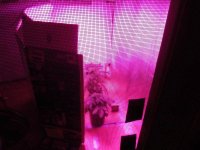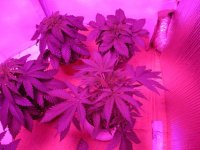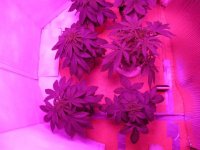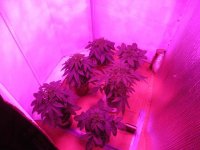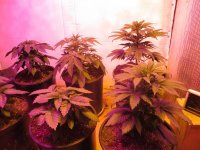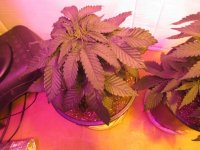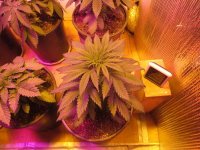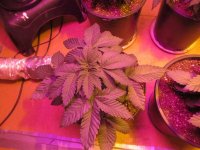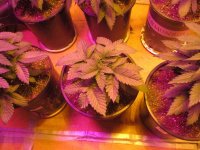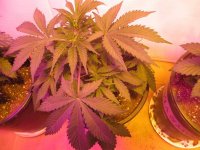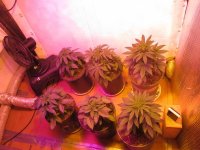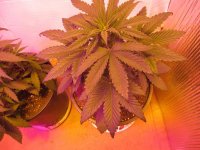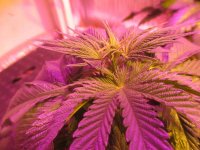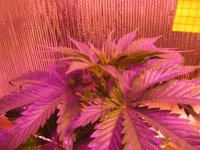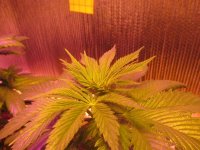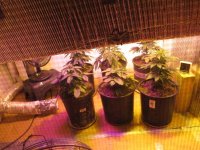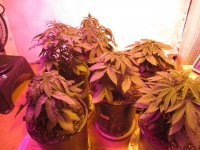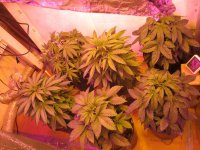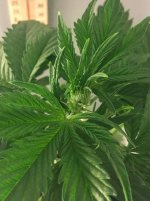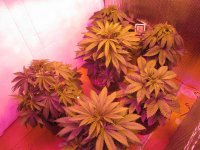-
Happy Birthday ICMag! Been 20 years since Gypsy Nirvana created the forum! We are celebrating with a 4/20 Giveaway and by launching a new Patreon tier called "420club". You can read more here.
-
Important notice: ICMag's T.O.U. has been updated. Please review it here. For your convenience, it is also available in the main forum menu, under 'Quick Links"!
You are using an out of date browser. It may not display this or other websites correctly.
You should upgrade or use an alternative browser.
You should upgrade or use an alternative browser.
creeper's out of the closet
- Thread starter Creeperpark
- Start date
using the best of both
using the best of both
My opinion only!!! Organic roots are small and very strong and have a different chemistry from the long fibrous synthetic roots of hydro or soil-less. There is a major difference in the productivity between those two root types. The slow growing organic root develops strong root tissue and builds a strong defense against disease and bug infestation. That’s the main reason that I use organic outdoors - because the strong disease resistance against bug infestation. Hydro and soil-less roots are more prone to bug infestation, and lockout. HOWEVER in my opinion, the hydro or soil-less is almost always stronger with a bigger yield in the end. I put the two of them together to have the best of both!!!
using the best of both
My opinion only!!! Organic roots are small and very strong and have a different chemistry from the long fibrous synthetic roots of hydro or soil-less. There is a major difference in the productivity between those two root types. The slow growing organic root develops strong root tissue and builds a strong defense against disease and bug infestation. That’s the main reason that I use organic outdoors - because the strong disease resistance against bug infestation. Hydro and soil-less roots are more prone to bug infestation, and lockout. HOWEVER in my opinion, the hydro or soil-less is almost always stronger with a bigger yield in the end. I put the two of them together to have the best of both!!!
how much water is good enough
how much water is good enough
Volumetric water content
Knowing my water holding capacity of my grow mix, in growing containers, is very important. It makes the difference between success, quality & yield. The two main reasons for learning water holding capacity is to avoid over and under watering. Overwatering can leach out nutrients and cut oxygen off completely. Under watering can lead to salt build up in the mix as well as dry pockets and damage tiny roots.
how much water is good enough
Volumetric water content
Knowing my water holding capacity of my grow mix, in growing containers, is very important. It makes the difference between success, quality & yield. The two main reasons for learning water holding capacity is to avoid over and under watering. Overwatering can leach out nutrients and cut oxygen off completely. Under watering can lead to salt build up in the mix as well as dry pockets and damage tiny roots.
don't laugh about turkey basters
don't laugh about turkey basters
Every time I draw water with the turkey baster, it oxygenates, and enriches the water with oxygen. Plants love it!! I use 2 sizes 50ml & 75ml, takes little time, but well worth the effort. Using basters increases root productivity 40% to 50% in soil-less mixes!
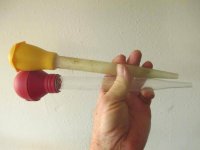
don't laugh about turkey basters
Every time I draw water with the turkey baster, it oxygenates, and enriches the water with oxygen. Plants love it!! I use 2 sizes 50ml & 75ml, takes little time, but well worth the effort. Using basters increases root productivity 40% to 50% in soil-less mixes!

finding water holding capacity
finding water holding capacity
Here’s how I find my water holding capacity for a 20 liter (5gal) container. Same with smaller sizes.
1st. I introduce 1 liter of water to the grow mix in the growing container with a turkey baster, 50 ml at a time. 20 plunges. I make sure and disperse the water evenly over of the top slowly.
2nd. I wait about 30 mins and do it again with a 2nd liter of water slowly with the turkey baster.
3rd. I wait last 30 min and this time using the baster add the water slowly until I just start to GET RUNOFF and STOP. For 20 liter (5gal) my water holding capacity is 3 liters and 300 ml per unit for the upcoming soil-less mix.
Now, I know how much to water my containers without over or under-watering.
finding water holding capacity
Here’s how I find my water holding capacity for a 20 liter (5gal) container. Same with smaller sizes.
1st. I introduce 1 liter of water to the grow mix in the growing container with a turkey baster, 50 ml at a time. 20 plunges. I make sure and disperse the water evenly over of the top slowly.
2nd. I wait about 30 mins and do it again with a 2nd liter of water slowly with the turkey baster.
3rd. I wait last 30 min and this time using the baster add the water slowly until I just start to GET RUNOFF and STOP. For 20 liter (5gal) my water holding capacity is 3 liters and 300 ml per unit for the upcoming soil-less mix.
Now, I know how much to water my containers without over or under-watering.
2 watering methods
2 watering methods
Since ppm, or EC are affected by water volume, I can keep or release nutrient content by using two different watering methods.
Shallow low volume watering, This does require more labor to monitor and apply more frequent irrigation's. . I use this mostly in the end, after depleting the ppm to help with the leaf fade. I use this mostly in flowering.
Thorough, Deep Watering, Works as long as there is plenty of airflow and no watering until the (peat mix) dries out. (use only with wet dry cycles).. I use this mostly in veg.
KNOWING water holding capacity, is so important using thorough deep watering.
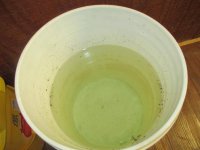
2 watering methods
Since ppm, or EC are affected by water volume, I can keep or release nutrient content by using two different watering methods.
Shallow low volume watering, This does require more labor to monitor and apply more frequent irrigation's. . I use this mostly in the end, after depleting the ppm to help with the leaf fade. I use this mostly in flowering.
Thorough, Deep Watering, Works as long as there is plenty of airflow and no watering until the (peat mix) dries out. (use only with wet dry cycles).. I use this mostly in veg.
KNOWING water holding capacity, is so important using thorough deep watering.

I've never used any cal mag supplements and never had a deficiency. I think 95 percent of the time it's a ph issue. That's why people should have a liquid ph test, as it's far more reliable (although less accurate) than an electronic pen. Those electronic ph pens go out of calibration very easily, and can be more of a curse than a help sometimes.
I like your water capacity testing ideas Your numbers are pretty much the same as mine, although I just do it by sight in a less scientific way. I'm looking forward to seeing this grow progress, although I do not know what your ultimate plan is yet
Your numbers are pretty much the same as mine, although I just do it by sight in a less scientific way. I'm looking forward to seeing this grow progress, although I do not know what your ultimate plan is yet 
I like your water capacity testing ideas
Pumpkin, I see so many people having watering issues on many different grow forums. The reason is not knowing water holding capacity. I m putting it out there for a newbie. Maybe save a seed from drowning, or a plant from mold damage. What goes in the pot, and what goes out is critical in the end! How can one monitor something if one doesn't know it?
Last edited:
transplanting into peat
transplanting into peat
When I transplant an organic plug into a soil-less peat mix, I always water the organic plug thoroughly and completely first! I DO NOT water the peat in the beginning! I let the wet organic plug sit in the dry peat for a couple of days, maybe even three days. This allows for the moisture and the EC of the organic plug to penetrate the peat. As the moisture penetrates the peat, the chemistry between the ions do their thing. When I see the plants just starting to wilt, I will give them their first full watering.
Since I know the watering holding capacity of my containers, I will give, 3L of water only, in the next watering.
transplanting into peat
When I transplant an organic plug into a soil-less peat mix, I always water the organic plug thoroughly and completely first! I DO NOT water the peat in the beginning! I let the wet organic plug sit in the dry peat for a couple of days, maybe even three days. This allows for the moisture and the EC of the organic plug to penetrate the peat. As the moisture penetrates the peat, the chemistry between the ions do their thing. When I see the plants just starting to wilt, I will give them their first full watering.
Since I know the watering holding capacity of my containers, I will give, 3L of water only, in the next watering.
I checked container weight in its dry state to find bottom low weight by picking the pot up. Temps rose to 90F (32c) at the base of the container, so tells me that the mix is ready for their first full watering. The heat is due to high-nitrogen in the peat and content from the organic plug. So I'm starting from the bottom with 500mi and adding 500ml on top. I'll wait 30 min and add 1L to the top. Pick up to check weight again, wait another 30 mins and water with 1 last liter.
Just rain water with cal mag
Just rain water with cal mag
Since the peat has a nutrient charge and the organic plug still is loaded with ppm, there's no reason to feed at this time. I have been using rain from the beginning. The next watering i will do a Leachate pourthru soil test and see what is in the container.
Just rain water with cal mag
Since the peat has a nutrient charge and the organic plug still is loaded with ppm, there's no reason to feed at this time. I have been using rain from the beginning. The next watering i will do a Leachate pourthru soil test and see what is in the container.
pourthru test 1st watering
pourthru test 1st watering
Went ahead and tested. 1st watering took 2 & 1/2L, and the ppm are at 800 to 1200=(2.5 EC) in the 6 different pots. pH is 6.6 "which is perfect to start adding the up coming General Hydro nutrients". My plan is to lower the pH down to 5.8 with nutrients only. No need for acid!
pourthru test 1st watering
Went ahead and tested. 1st watering took 2 & 1/2L, and the ppm are at 800 to 1200=(2.5 EC) in the 6 different pots. pH is 6.6 "which is perfect to start adding the up coming General Hydro nutrients". My plan is to lower the pH down to 5.8 with nutrients only. No need for acid!
fabric vs plastic
fabric vs plastic
I hear a lot of people talking about fabric vs plastic containers but, I never hear anyone talk about this.
Standard plastic containers with holes on the bottom are not made to sit flat on the floor. They are made to sit on racks or gavel which allows the bottom air holes equal exposure as the top. If the airflow is stopped on the bottom the air drying at the bottom is fucked up! The container can’t dry equally as the top, so improper air flow from the bottom causes over watering issues (mold)! Plastic works well if you use it right.
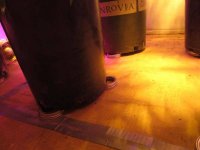
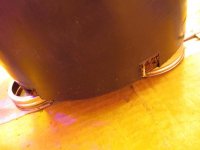
fabric vs plastic
I hear a lot of people talking about fabric vs plastic containers but, I never hear anyone talk about this.
Standard plastic containers with holes on the bottom are not made to sit flat on the floor. They are made to sit on racks or gavel which allows the bottom air holes equal exposure as the top. If the airflow is stopped on the bottom the air drying at the bottom is fucked up! The container can’t dry equally as the top, so improper air flow from the bottom causes over watering issues (mold)! Plastic works well if you use it right.


Starting low EC feeding.” IMPORTANT” using this method it’s important to remember that once you start your nutrients you never run plain water again until last 2 to 3 weeks of flowering! If you run just plain water you will get a nutrient disorder. You can reduce but never stop the nutrients!
Latest posts
-
-
Tutorial CanG | Regeln für Grower und Konsumenten in Deutschland
- Latest: Hermanthegerman
-
-
-
Latest posts
-
-
Tutorial CanG | Regeln für Grower und Konsumenten in Deutschland
- Latest: Hermanthegerman
-
-
-

